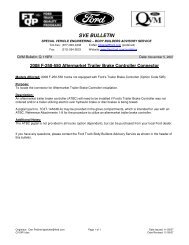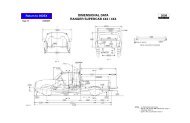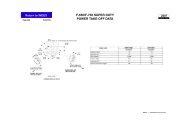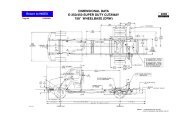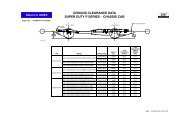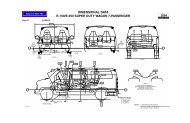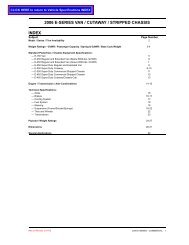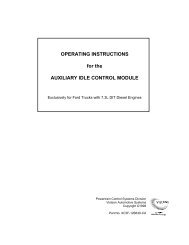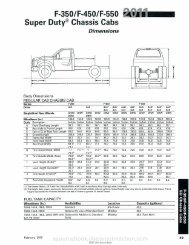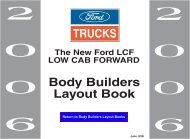2012 super duty f-series incomplete vehicle manual - Ford Fleet
2012 super duty f-series incomplete vehicle manual - Ford Fleet
2012 super duty f-series incomplete vehicle manual - Ford Fleet
You also want an ePaper? Increase the reach of your titles
YUMPU automatically turns print PDFs into web optimized ePapers that Google loves.
Incomplete Vehicle Manufacturer – a person [company that<br />
(CMVSR)] who manufactures an <strong>incomplete</strong> <strong>vehicle</strong> by<br />
assembling components none of which, taken separately,<br />
constitute an <strong>incomplete</strong> <strong>vehicle</strong>. (49CFR567.3)<br />
Intermediate Manufacturer – a person [company (CMVSR)],<br />
other than the <strong>incomplete</strong> <strong>vehicle</strong> manufacturer or the<br />
final stage manufacturer, who [that (CMVSR)] performs<br />
manufacturing operations on a <strong>vehicle</strong> manufactured in two<br />
or more stages. (49CFR567.3)<br />
Motor Home – a multi-purpose <strong>vehicle</strong> with motive power that is<br />
designed to provide temporary residential accommodations,<br />
as evidenced by the presence of at least four of the following<br />
facilities: cooking; refrigeration or ice box; self-contained<br />
toilet; heating and/or air conditioning [system that can<br />
function independently of the <strong>vehicle</strong> engine (CMVSR)]; a<br />
potable water supply system including a faucet and a sink;<br />
and a separate 110-125 volt electrical power supply and/or<br />
an LP gas supply. (49CFR571.3)<br />
Multifunction School Activity Bus (MFSAB) – a school bus<br />
whose purposes do not include transporting students to and<br />
from home or school bus stops. (49CFR571.3)<br />
Multipurpose Passenger Vehicle (MPV) – a motor <strong>vehicle</strong><br />
with motive power, except a low-speed <strong>vehicle</strong> or trailer,<br />
designed to carry 10 persons or less which is constructed<br />
either on a truck chassis or with special features for<br />
occasional off-road operation. (49CFR571.3)<br />
Multipurpose Passenger Vehicle (MPV) (Canada) – a <strong>vehicle</strong><br />
having a designated seating capacity of 10 or less that is<br />
constructed either on a truck-chassis or with special features<br />
for occasional off-road operation, but does not include an<br />
air cushion <strong>vehicle</strong>, an all-terrain <strong>vehicle</strong>, a golf cart, a lowspeed<br />
<strong>vehicle</strong>, a passenger car, a three-wheeled <strong>vehicle</strong>, a<br />
truck or a <strong>vehicle</strong> imported temporarily for special purposes.<br />
(véhicule de tourisme à usages multiples)<br />
Pickup Box Delete – a Chassis Cab <strong>incomplete</strong> <strong>vehicle</strong><br />
created by ordering a Pickup Box Delete option on an<br />
otherwise completed <strong>vehicle</strong>. (<strong>Ford</strong> Motor Company)<br />
School Bus – a bus that is sold, or introduced in interstate<br />
commerce, for purposes that include carrying students to<br />
and from school or related events, but does not include a<br />
bus designed and sold for operation as a common carrier<br />
in urban transportation. (49CFR571.3)<br />
School Bus (Canada) – a bus designed or equipped primarily<br />
to carry students to and from school. (autobus scolaire)<br />
Seating Reference Point – the unique design H-point, as<br />
defined in SAE J1100 (June 1984), which:<br />
(a) Establishes the rearmost normal design driving or riding<br />
position of each designated seating position in a <strong>vehicle</strong>;<br />
(b) Has X, Y, and Z coordinates established relative to the<br />
designed <strong>vehicle</strong> structure;<br />
(c) Simulates the position of the pivot center of the human<br />
torso and thigh; and<br />
(d) Is the reference point employed to position the two-<br />
dimensional drafting template described in SAE J826<br />
(May 1987).<br />
(abbreviated by <strong>Ford</strong> Motor Company)<br />
Seating Reference Point (Canada) – the unique Design<br />
H-point, as defined in section 2.2.11.1 of SAE Recommended<br />
Practice J1100 (June 1993), that:<br />
(a) establishes the rearmost normal design driving or riding<br />
position of each designated seating position, taking into<br />
account all modes of adjustment – horizontal, vertical<br />
and tilt – in a <strong>vehicle</strong>,<br />
DEFINITIONS<br />
4<br />
(b) has X, Y and Z coordinates, as defined in section 2.2.3<br />
of SAE Recommended Practice J1100 (June 1993),<br />
established relative to the designed <strong>vehicle</strong> structure,<br />
(c) simulates the position of the pivot centre of the human<br />
torso and thigh, and<br />
(d) is the reference point employed to position the H-point<br />
template with the 95th percentile leg, as described in<br />
section 3.1 of SAE Standard J826 (June 1992), or, if that<br />
drafting template cannot be positioned, the reference<br />
point when the seat is in its rearmost adjustment position.<br />
(point de référence de position assise)<br />
Second Unit Body (SUB) – consists of the body structure<br />
and/or all the cargo carrying, work performing, and/or<br />
load bearing components and/or equipment installed by a<br />
subsequent stage manufacturer on an <strong>incomplete</strong> <strong>vehicle</strong>,<br />
such that the <strong>incomplete</strong> <strong>vehicle</strong> becomes a completed<br />
<strong>vehicle</strong>. (<strong>Ford</strong> Motor Company)<br />
Service Body – a type of Second Unit Body (SUB) that<br />
incorporates structural side and rear panels that extend<br />
below frame rail height. (<strong>Ford</strong> Motor Company)<br />
Subsequent Stage Manufacturer – a term which means<br />
either intermediate or final stage manufacturers or both.<br />
(<strong>Ford</strong> Motor Company)<br />
Trimmed Seat – a complete functional seat assembly including<br />
the seat pedestal, seat track, seat base frame, seat back,<br />
recliner mechanism, seat padding, all attaching hardware,<br />
and the final trim material (i.e., cloth, leather, or vinyl). (<strong>Ford</strong><br />
Motor Company)<br />
Truck – a motor <strong>vehicle</strong> with motive power, except a trailer,<br />
designed primarily for the transportation of property or<br />
special purpose equipment. (49CFR571.3)<br />
Truck (Canada) – a <strong>vehicle</strong> designed primarily for the<br />
transportation of property or special-purpose equipment<br />
but does not include a competition <strong>vehicle</strong>, a crawlermounted<br />
<strong>vehicle</strong>, a trailer, a work <strong>vehicle</strong>, a <strong>vehicle</strong> imported<br />
temporarily for special purposes or a <strong>vehicle</strong> designed for<br />
operation exclusively off-road. (camion).<br />
Unloaded Vehicle Weight (UVW) – the weight of a <strong>vehicle</strong><br />
with maximum capacity of all fluids necessary for operation<br />
of the <strong>vehicle</strong>, but without cargo, occupants, or accessories<br />
that are ordinarily removed from the <strong>vehicle</strong> when it is not<br />
in use. (49CFR571.3)<br />
Unloaded Vehicle Weight (Canada) – the weight of a <strong>vehicle</strong><br />
equipped with the containers for the fluids necessary for the<br />
operation of the <strong>vehicle</strong> filled to their maximum capacity, but<br />
without cargo or occupants. (poids du véhicule sans charge)<br />
Untrimmed Seat – the structure including the seat pedestal,<br />
seat track, seat base frame, seat back, recliner mechanism,<br />
seat padding, and all attaching hardware required for a<br />
functional seat assembly without the final trim material<br />
(e.g., cloth, leather, or vinyl) and trim material attaching<br />
components. (<strong>Ford</strong> Motor Company)<br />
Walk-In Van – a step entry city delivery van type <strong>vehicle</strong> that<br />
permits a person to enter the <strong>vehicle</strong> without stooping. This<br />
definition by <strong>Ford</strong> Motor Company is based on information<br />
appearing in 41 FR 54945, published December 16,1976,<br />
and in 42 FR 34288, published July 5,1977.<br />
Walk-In Van (Canada) – a van type of truck in which a person<br />
having a height of 1700 mm can enter the occupant<br />
compartment in an upright position by a front door. (fourgon<br />
à accès en position debout)<br />
F-SERIES (February, 2011)



